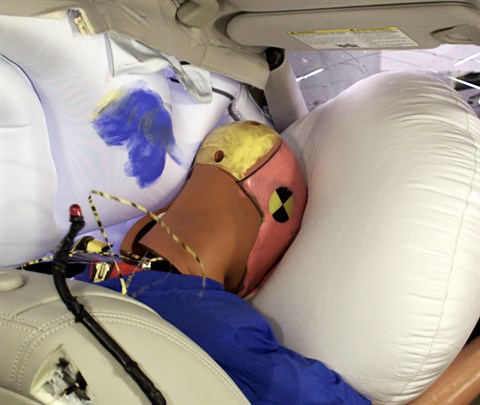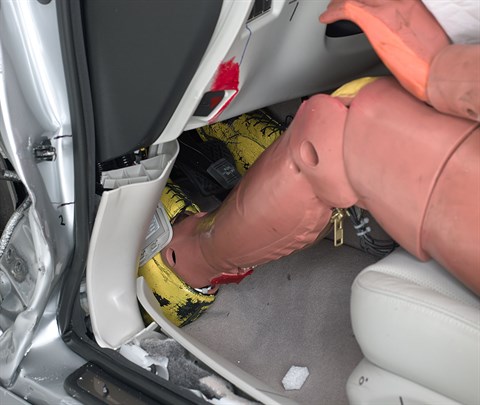Small overlap front: driver-side
Rating applies to 2014-15 models
Tested vehicle: 2014 Infiniti Q50 3.7 Premium 4-door
The Infiniti G was redesigned for the 2014 model year and renamed the Q50.
| Evaluation criteria | Rating |
|---|---|
| Structure and safety cage | |
| Driver injury measures | |
| Head/neck | |
| Chest | |
| Hip/thigh | |
| Lower leg/foot | |
| Driver restraints and dummy kinematics | |

Action shot taken during the small overlap frontal crash test.

The dummy's position in relation to the door frame, steering wheel, and instrument panel after the crash test indicates that the driver's survival space was maintained reasonably well.

The frontal and side curtain airbags worked well together to keep the head from coming close to any stiff structure or outside objects that could cause injury.

Footrest, parking brake, and instrument panel intrusion contributed to a significant risk of injury to the left lower leg.
Moderate overlap front: original test
Rating applies to 2014-15 models
Tested vehicle: 2014 Infiniti Q50S Hybrid 4-door 4wd
The Infiniti G was redesigned for the 2014 model year and renamed the Q50. Moderate overlap frontal ratings are assigned by the Institute based on a test conducted by Nissan.
| Evaluation criteria | Rating |
|---|---|
| Overall evaluation | |
| Structure and safety cage | |
| Driver injury measures | |
| Head/neck | |
| Chest | |
| Leg/foot, left | |
| Leg/foot, right | |
| Driver restraints and dummy kinematics | |
Side: original test
Rating applies to 2014-24 models
Tested vehicle: 2014 Infiniti Q50 3.7 Premium 4-door 4wd with standard front and rear head curtain airbags and standard front seat-mounted torso airbags
The Infiniti G was redesigned for the 2014 model year and renamed the Q50. Side ratings are assigned by the Institute based on a test conducted by Nissan.
| Evaluation criteria | Rating |
|---|---|
| Overall evaluation | |
| Structure and safety cage | |
| Driver injury measures | |
| Head/neck | |
| Torso | |
| Pelvis/leg | |
| Driver head protection | |
| Rear passenger injury measures | |
| Head/neck | |
| Torso | |
| Pelvis/leg | |
| Rear passenger head protection | |
Roof strength
Rating applies to 2014-23 models
Tested vehicle: 2014 Infiniti Q50 3.7 Premium 4-door
| Overall evaluation | |
|---|---|
| Curb weight | 3,652 lbs |
| Peak force | 19,309 lbs |
| Strength-to-weight ratio | 5.29 |
Head restraints & seats
Seat type: Power leather seat
| Overall evaluation | |
|---|---|
| Dynamic rating | |
| Seat/head restraint geometry |
About the head restraint & seat test
Currently, IIHS tests apply only to front seats.
